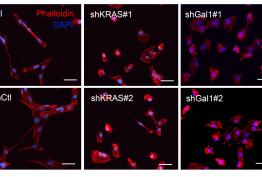The study shows that the cannabinoid receptor CB1 (CB1R), the main molecular target of the bioactive components of cannabis, specifically interacts with an intracellular protein called BiP. The interaction between CB1R and BiP occurs selectively at terminals of GABAergic (inhibitory) neurons and induces a marked change in the signaling profile associated with CB1R. The CB1R-BiP complexes would act as fine-tuners of anxiety, one of the most common unwanted effects of cannabis use.
The work, led by Manuel Guzmán (Complutense University of Madrid), has been carried out in the context of a collaborative project of CIBERNED with the participation of M Teresa Vilaró, Guadalupe Mengod and Roser Cortés from the IIBB, and researchers from the Universities of Barcelona, Basque Country and Queen Mary of London, and INSERM among others.
The in situ hybridization image obtained by MT Vilaró from the IIBB has been published on the cover of the issue.
CITA:
Costas-Insua C, Moreno E, Maroto EB, Ruiz-Calvo A, Bajo-Grañeras R, Martín-Gutiérrez D, Diez-Alarcia R, Vilaró MT, Cortés R, García-Font N, Martín R, Espina M, Botta J, Ginés S, McCormick PJ, Sánchez-Prieto J, Galve-Roperh I, Mengod G, Urigüen L, Marsicano G, Bellocchio L, Canela EI , Casadó V, Rodríguez-Crespo I and Guzmán M
The Journal of Neuroscience, 2021, 41(38):7924–7941
DOI: /doi.org/10.1523/JNEUROSCI.0821-21.2021







